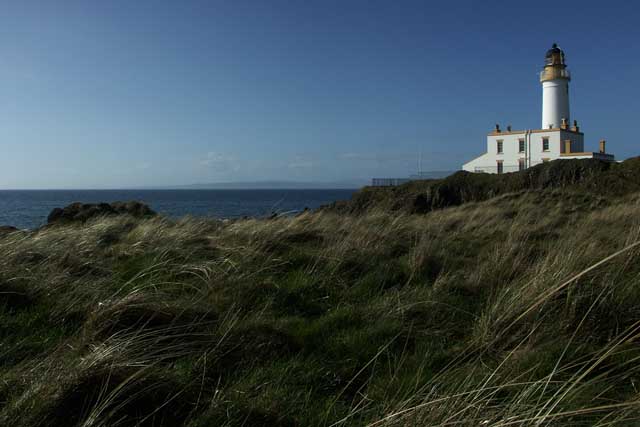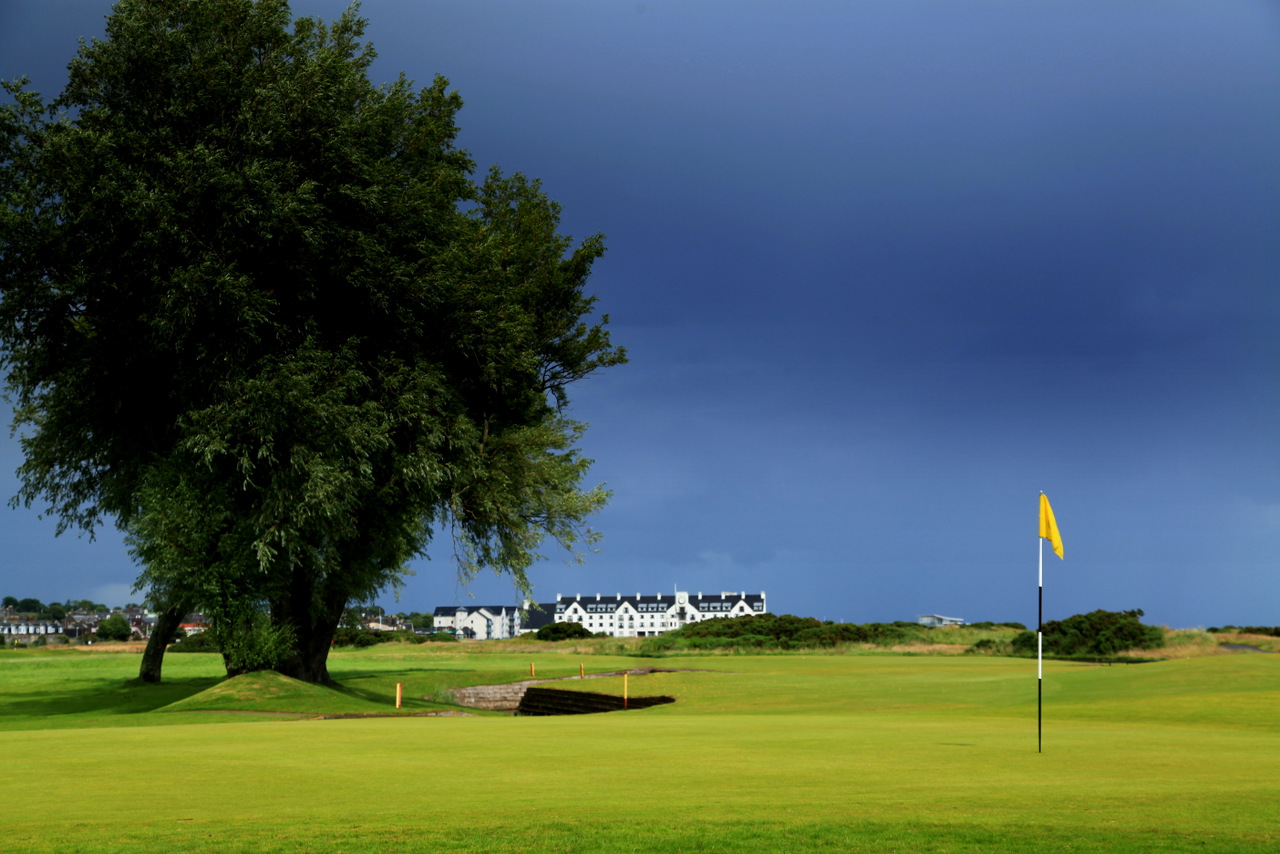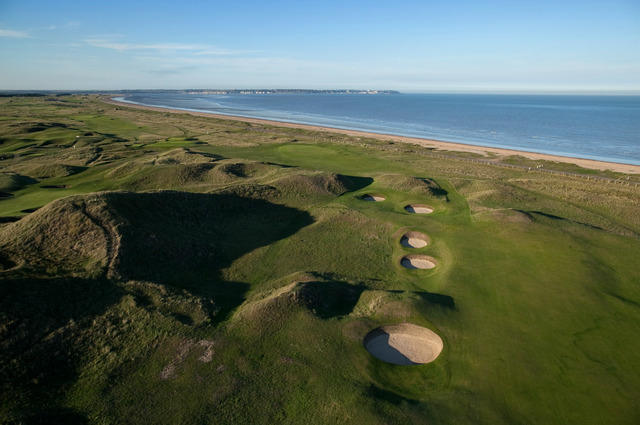Roderick Easdale nominates his pick of the best golf courses in Britain and Ireland, with some help from the great and the good of the game.
St Andrews Old Course, Fife
Best for: The real thing
The home of golf, where the sport has been played for 600 years – yet which is still a great test of the game today. Tiger Woods, who won two of his Opens here, says: ‘It’s my favourite course. The history is amazing. To win at St Andrews is the ultimate.’ Jack Nicklaus concurs: ‘If a golfer is to be remembered, he must win the Open at St Andrews.’ (Nicklaus did this in 1970 and 1978.)
St Andrews is the home of the Royal and Ancient Golf Club, responsible, to this day, for the rules of the game. The Old Course begat the now worldwide standard layout of 18 holes. Early courses were of any number of holes, and indeed St Andrews used to have 22 – 11 running out along the shoreline and 11 back, with golfers going in either direction putting into the same cups except on the 11th and 22nd. Eventually it was decided that the first four (and thus the last four, too) were too short, these were amalgamated into two holes.
Many of the Old Course’s other features have not been copied, however. The Old Course has only two par-three holes and two par-fives, whereas most standard modern courses have at least four of each. Nor have many courses adopted St Andrews’ famous double greens. When golf became more popular in the mid 19th century, St Andrews’ design, requiring two sets of golfers playing to the same hole, became unworkable. So two holes were cut on each green, with a white flag signalling the outward hole and red flags for the inward ones.
Sunningdale Old Course, Berkshire
Best for: Golfing perfection
The Old Course at Sunningdale is probably as close as you get to golfing perfection. The staff at this traditional club are genuinely friendly and the caddies knowledgeable and enthusiastic. The course is a beautiful heathland one with slick greens and wonderful vistas; a bonus is the halfway hut’s famous sausages.
Early golf courses were often on links land (between the coast and more fertile land inland), which was unsuitable for farming, as were other heathland areas. Such land abounds in Surrey and Berkshire, so this stretch of the country has provided the UK with some of its best courses.
Turnberry, Ayrshire

Best for: Views
Few places in Britain are as magical on a sunny summer’s evening than this part of the west coast of Scotland; fewer still have a magnificent golf course to enjoy while you soak in the surroundings. This much-beloved course is, surprisingly, one of the newer creations on this page having only been laud out in its present form in 1951 (the land was an RAF base during the Second World War) but what it lacks in age it more than makes up for in quality.
The course is interesting and a fine throughout, but what lifts it up is the stretch of holes played along the clifftops from the 4th to the 11th holes. The combination of vast, rolling dunes and sweeping views out towards Ailsa Craig will stir your soul, while the golfing challenge of threading your way through the scenery is guaranteed to put a grin on your face.
Wentworth West Course, Surrey

Best for: Prime property
Right from the start, Wentworth was about property as well as golf. The 1,750 acres hold about 800 houses, as well as three full-length golf courses – and South African legend Ernie Els is one of many top professionals who live on the Wentworth estate. His house overlooks the 16th hole on the West Course. ‘Prime property here is often considered to be that backing on to the West Course,’ says James Wyatt, of local estate agents Barton Wyatt. ‘The “super prime” golf properties hold a premium of at least 20%, and, on the whole, Wentworth commands higher prices than other locations in the area.’
The course has had its share of controversies in recent times: a re-design in 2009 (led by Els) was widely criticised, and there have been a few battles between the club’s recently-installed Chinese owners and its members – and one of the changes is that it is now more private (and therefore harder to get a tee time) than it has been for many years. But it remains a fine course, and is all the more enjoyable to play because of its familiarity from so many years of televised tournament.
Royal Portrush, Co Antrim
Best for: An Irish welcome
The venue for the 2019 Open Championship has always been a superb golf course, but the changes made by the R&A ahead of the tournament elevated it still further. Two new holes have been built which already feel like they’ve been there for years, replacing the weak closing pair of holes and making the epic long par-3, ‘Calamity’, a dramatic 16th hole instead of the 14th.
George O’Grady, former chief executive of the European Tour, nominates the Dunluce Course at Royal Portrush ‘simply because it has it all. It is a tremendous test of golf with some of the most beautiful views imaginable across the Atlantic as your eyes sweep round from the Donegal hills in the west to the Skerries in the east. The bracing sea air gives you an appetite for lunch and the wonderful Irish hospitality in the clubhouse’.
West Sussex, Pulborough
Best for: Lunch
Golf clubs are renowned for the quality of their lunches. At one club, I wished an old boy ‘good luck’ as he was about to tee off. ‘Young man,’ he replied, ‘I am here to enjoy a walk before an excellent lunch. Anything else that may happen I shall view as a bonus.’ Jeremy Slessor, managing director of course architects European Golf Design, put forward West Sussex because ‘the club has the best lunch in the UK. Plus, the course is incredibly beautiful, challenging without being brutally long, traditional, quirky and enormous fun.’
Swinley Forest, Ascot, Berkshire

The Queen Mother playing golf on honeymoon.
Best for: Royal connections
The Queen Mothers used to enjoy lunching here, as the Dukes of Edinburgh and York were members, and its origins lie in a remark by Queen Victoria. When Lord Derby was late for a meeting with the monarch, having been held up by a slow fourball at Sunningdale, the queen chided him: ‘Surely, a man in your position should have his own course.’ So he bought a chunk of Swinley Forest and asked Harry Colt, the pro at Sunningdale, to design him exactly that. The result is a superb, demanding, but not too long, course with gorgeous rhododendrons – though you’ll need to know someone (or know someone who knows someone) if you want to play: it’s a private club that doesn’t even have a website.
It is said the unnatural zigzag in the stream that crosses the 1st and 18th fairway is due to Lord Derby having it diverted because he was unable to clear it with his tee shot. If true, he would have echoed Edward VII’s actions when having a private course laid out. The king played the proposed layout, when the positions of bunkers were indicated by hurdles, with Sir Frederick Ponsonby, who reported that the king ‘invariably drove up against the hurdles’, and demanded they be moved further away. By the third day, Sir Frederick wrote: ‘The hurdles at all the holes had been moved to different spots indicated by the king. Again, he never failed to drive into them and, in a voice of thunder, asked who had been stupid enough to place them there.’
Walton Heath Old Course, Surrey
Best for: Cabinet meetings
Although 16 of the past 19 American Presidents have been golfers, recent Prime Ministers have shown little interest. This was not always so: on the eve of the First World War, Walton Heath had four future or past Prime Ministers, 24 MPs and 21 members of the House of Lords among its membership. George W. Bush stopped playing during the Iraq War, feeling it was improper, but Lloyd George – who, with Churchill, even continued sitting on club committees – felt no such compunction. ‘The war is being conducted from Walton Heath’s 19th hole,’ it was remarked of his government. Churchill (handicap 18) was said not to be as keen as Lloyd George (handicap 13), finding the clubhouse more congenial, and frequently had to be chivvied out to play.
Reputedly, he was a mediocre golfer, a problem he sought to solve by pairing up with James Braid, Walton Heath’s professional and five-times winner of the Open. Walton Heath has two excellent courses, the better being the Old Course, designed by Herbert Fowler.
Beau Desert, Staffordshire
 Best for: Nature
Best for: Nature
Winding its way through Staffordshire’s Cannock Forest is another Herbert Fowler creation, Beau Desert. ‘It’s one of the loves of my life, as I was born not much more than two good hits from the course,’ explains Phil Weaver, chairman of the Professional Golfers’ Association. He remembers: ‘As a boy, I cycled there after school and, when the members were not about, whacked my ball up and down the fairway on the 5th hole. When golfers appeared, I scampered off and hid in the trees. Beau Desert is challenging and picturesque with pine, birch and heather abounding on a gently undulating landscape-a beautiful setting at one with Nature.’
The UK’s 3,300 golf courses cover about 400,000 acres. Bob Taylor of the Sports Turf Research Institute Ecology and Environment Unit points out: ‘Courses not only offer valuable green spaces in urban settings, but are guardians of often rare and declining habitats and green corridors that can be stop-off points for passage and migration.’
Royal Birkdale, Merseyside
 Best for: Biodiversity
Best for: Biodiversity
It’s a common misconception that golf courses are bad for the environment through their use of fertiliser and pesticide. In fact, both are used sparingly – fertilise a fairway and you can ruin it, as the best grasses for golf, fescue and bent, prosper in nutrient-poor soil. Golf courses have actually become increasingly important for biodiversity. Under the recent English Golf Advisory Service scheme, 29 courses have introduced or extended areas of heather.
More than six miles of hedgerow have been created, nearly 500 bird boxes erected, and 375 acres of rough grassland introduced, to benefit insects, small mammals and groundnesting birds. Royal Birkdale provides nesting accommodation for skylarks, plus homes for other rare wildlife such as the natterjack toad, red squirrel, sand lizard and many unusual plant species, including several types of orchid.
This club has hosted nine Opens and will host a 10th this summer. But it was also the venue for one of the most famous moments in Ryder Cup history, in 1969. In the final match, Tony Jacklin was left with a missable two-footer to tie both his match with Jack Nicklaus and the whole contest. In a celebrated act of sportsmanship, Nicklaus conceded the putt.
‘I didn’t think you’d miss that putt,’ Nicklaus said to Jacklin, as he offered his hand, ‘but I didn’t want to give you the chance.’
Royal Worlington & Newmarket, Suffolk
Best for: a nine-hole track
A location manager scouting for somewhere to film P.G. Wodehouse’s ‘Oldest Member’ stories couldn’t do better than this club’s appealingly old-fashioned clubhouse.
The course is, with good reason, often described as the UK’s best nine-hole track. It has an attractive, open layout that, although inland, is reminiscent of a links in its windswept, uncluttered, subtly undulating fairways.
The Addington, Surrey
Best for: Taking up membership
P.G. Wodehouse was a keen, but, by his own unreliable testimony, indifferent golfer. He once wrote that anyone wishing to contact him could do so ‘c/o the 6th bunker, The Addington Golf Club, Croydon, Surrey’. The holes up to this point are unexciting, but, from then on, there are some glorious, occasionally quirky, heathland ones with the 9th, 13th and 17th particularly outstanding.
The Addington is one of many clubs happy to advertise membership vacancies. Waiting lists were once prevalent – The Addington’s used to be many years’ long – but not any more. The English Golf Union estimates that 87% of its clubs now have places available, partly because the modern golfer is less likely than his predecessors to become a club member.
St Enodoc, Cornwall
 Best for: Splendid views
Best for: Splendid views
Another writer who enjoyed his golf was Sir John Betjeman, who is buried in the churchyard of St Enodoc’s church, around which run five holes of St Enodoc’s Church Course. A birdie on the 13th prompted him to write a poem of celebration, which concludes:
Ah! Seaweed smells from sandy caves
And thyme and mist in whiffs, In-coming tide,
Atlantic waves
Slapping the sunny cliffs,
Lark song and sea sounds in the air
And splendour, splendour everywhere.
The most famous holes on this course are the 10th, the fairway of which runs past the church, and the 6th, with its huge bunker ‘the Himalayas’, which rises 75ft between tee and green. The 9th is as pretty a hole as I have encountered, with its green beautifully framed by wooded Brea Hill and the estuary running along its fairway.
St Enodoc is golf photographer Kevin Murray’s choice. ‘It has some of the greatest sea views of any course in the world and its punishing rough, undulating fairways and firm greens all add to a great experience. Any visitor who plays to their handicap here feels that they have done really well.’
Royal St George’s, Kent
Best for: 007 connections
Royal St George’s has a famously huge bunker, described as ‘one of the tallest and deepest in the United Kingdom’ by no less a source than Ian Fleming in Goldfinger. The course, where James Bond plays the eponymous villain, is thinly disguised in the book as St Mark’s: the fictional pro is Alfred Blacking, while St George’s pro at the time was Albert Whiting. It’s hardly surprising: Fleming was a member, playing with a swing described as ‘a housemaid brushing the floor’ and to a handicap of nine – one of many of his own attributes that he bestowed on Bond.
The author was due to become the next captain of the club when he died of a heart attack aged 56 – a month before the film of Goldfinger was released. Fleming didn’t miss seeing his course on the big screen, however: the famous scenes with Sean Connery were filmed at Stoke Park in Buckinghamshire.
Royal Porthcawl, Glamorgan
 Best for: Unchanging standards
Best for: Unchanging standards
Michael Williams once wrote in The Daily Telegraph that Royal Porthcawl ‘epitomises all that is best about the game as it once was, even down to a creaking clubhouse that is as unchanging as the magnificent links’. It’s the selection of Keith Lloyd, chief executive of the Golf Club Managers’ Association: ‘What this course may possibly lack in length is more than made up for by fast, true greens, challenging undulations, the influence of the wind in accordance with tidal changes and its clever bunkering.’
Nefyn & District Old, Gwynedd
Best for: Quirkiness
I don’t think anyone can argue against Nefyn & District, on a slender peninsula on the north Welsh coast, having the best 26-hole layout, as I know of no such similar arrangement. The club has two courses: the Old and New. Both are played over the same first 10 holes before they diverge.
‘The final eight holes of the Old Course are one of the most liberating golfing experiences you’ll ever have,’ says former Golf Monthly courses editor Jeremy Ellwood. ‘Whoever thought of laying them out on this wafer-thin headland was a genius or a lunatic – or perhaps a perfect marriage of the two.’
Royal County Down, Co Down
 Best for: Practising for the Open
Best for: Practising for the Open
Royal County Down has been a frequent stop for many overseas golfers, among them Tiger Woods and five-time Open winner Tom Watson, looking to practise their links skills before the Open. ‘This course is a pure links in the truest sense of the word,’ says Watson. ‘It’s a tremendous test, and the outward half is as fine a nine holes as I’ve ever played.’
Carnoustie, Angus
 Best for: A tough game
Best for: A tough game
The 1999 Open at Carnoustie saw the course dubbed ‘Carnasty’, so tough was it. Frenchman Jean Van de Velde needed six or better on the par-4 closing hole to win. Eschewing safety-first tactics – ‘to me, it was against the spirit of the game to win that way,’ he explained later – he picked up his driver rather than bunting a 3-iron down the middle, sliced his drive onto the wrong fairway, ricocheted off the grandstand into deep rough, plonked his ball into the Barry Burn and hit into a bunker en route to making a seven. He lost in the play-off to Scotland’s Paul Lawrie.









 Best for: Splendid views
Best for: Splendid views


